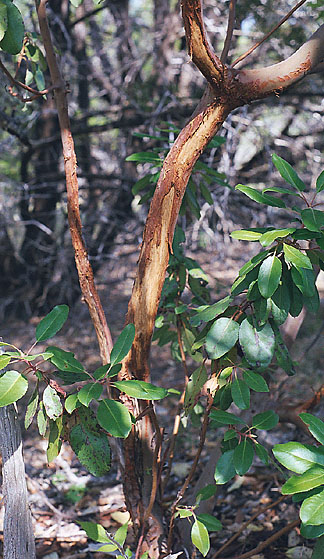

Deer do not usually browse madrone foliage, but small trees are subject to antler-rubbing attacks. Deer would appear to have to learn that madrones do not taste good, as from time to time small branches are found bitten off (uneaten) beneath a small tree. With no attempt made to protect my madrones, over 500 in number in 2009, even during recent droughts the only noticeable deer damage has been in the fall, from antlers.

|
Porcupine Damage in two different years |
|---|
In the past several years numerous instances of bark stripping by porcupines — as in the above photo (with clear tooth marks) — has been noticed in late winter/early spring. (We did see the porcupine in the general area of the damage.) Madrone bark seems to be a favorite porcupine food. The bark is only taken from one side of a (young) tree, which sometimes causes the madrone to die out above that point, accompanied by bushing out at the base of the tree, but this has never killed the tree itself. Unlike the sensitivity to root damage, the madrones recover quickly from damage to branches, even from severe antler-whacking.
Raccoons do eat the berries, and I have seen severe raccoon damage to higher branches of a tree a mile away, but none to our trees.
Armadillos have destroyed a very high percentage of my seedlings placed or started in the ground. Sometimes it takes half a year, but sooner or later they seem to locate and dig up any madrone on their turf that is not protected in some way.
Insects generally do not bother young plants, but .... My first attempt to introduce very young and tender seedlings into the ground - they had germinated indoors and had just produced the first leaves - was to put some 5 plants in each of 12 different locations one evening. The next morning every plant that had been placed in what appeared to be good bottomland soil near the creek, half of the total, had been eaten. None of the plants in 'high and dry' areas had been touched. I am convinced that pillbugs did the deed. Of the remaining 30, six reached 5 feet and four were still going strong 22 years later as larger trees. [One tree died after 30 years. It was in deep clay.]
Insect predation might also account for the fact that our volunteer seedlings are, with few exceptions, uphill from the mother tree, and the absence of madrones from well-drained but lusher areas that might otherwise seem suitable.
One of the lessons I learned early on was that watering an individual plant or small area during a dry period will serve as magnet for numerous predators, especially armadillos and termites. If plants are planted in a milk carton, be careful not to water just that limited area. Once the termites arrive, they will eat the carton and the madrone roots.
I put plants in the ground only when the ground is otherwise wet. Watering at that time will not be noticed by the predators.